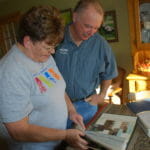The hardest to learn is the least complicated
 Practical Farmers now has a farm transition page on our website, whereby we are collecting the experiences of PFI members on how to transition farmland and farm businesses. There will be more stories added to the site over the coming years, but even now the site contains a tremendous amount of farmer knowledge and wisdom. There is a lot of humility in these stories as well. After all, farmland owners and operators are making momentous decisions as they work to keep their families together while creating a viable agriculture for future generations.
Practical Farmers now has a farm transition page on our website, whereby we are collecting the experiences of PFI members on how to transition farmland and farm businesses. There will be more stories added to the site over the coming years, but even now the site contains a tremendous amount of farmer knowledge and wisdom. There is a lot of humility in these stories as well. After all, farmland owners and operators are making momentous decisions as they work to keep their families together while creating a viable agriculture for future generations.
Visit https://www.practicalfarmers.org/member-priorities/farm-transitions/ to see the site.
There is a line in a song I love that goes like this: “The hardest to learn is the least complicated.” Isn’t that the truth.
Here is something that doesn’t seem very complicated: Set your goals first. Isn’t it simple to decide first where you want to go and then choose the path that will get you there? But many of us start out this direction or that one, and in the end are somewhere else without having decided on our final destination to begin with.
I admire Tom and Irene Frantzen, in part because their intellectual curiosity and training in Holistic Management led them to set their goals first–and then stick with them. The Frantzens’ goal for their farm? “Long-term protection for a true Iowa family farm that has significant conservation features blended into a working landscape.”
Most of us are thinking one, two, maybe five years down the line. The Frantzens are thinking out generation after generation, and we should all learn from their example.
I quote from them: “This farm has a story that started 100 years ago. Our farm is profitable and we provide sustainable employment. It is a good place to work and an important part of a rural community. It involves many other businesses in very positive ways. Down the road, maybe it will even support more families. There are no rules saying what the farm has to look like in the future. One hundred years ago, it was carved out of a chunk of tallgrass prairie, and it has been changed enormously in many different ways since.
“A former Supreme Court justice said that you can have great concentration of wealth or you can have democratic process. You cannot have both. We find the concentration of land ownership and the escalation of its worth very destructive to rural communities. We find those factors a huge threat to democratic process.
“We personally can’t change those trends that are going on, but we don’t have to be a part of them either. To divide up this farm and sell its assets off to the highest bidder is in complete conflict with our goals. Our children understand this. They realize that because of our generational transfer plan, they won’t benefit from this current run-up in land values. They understand the love and care and the legacy of the land we are trying to preserve.”
Please join Tom and Irene in having the courage to set your farm transition goals–and then implement them.
